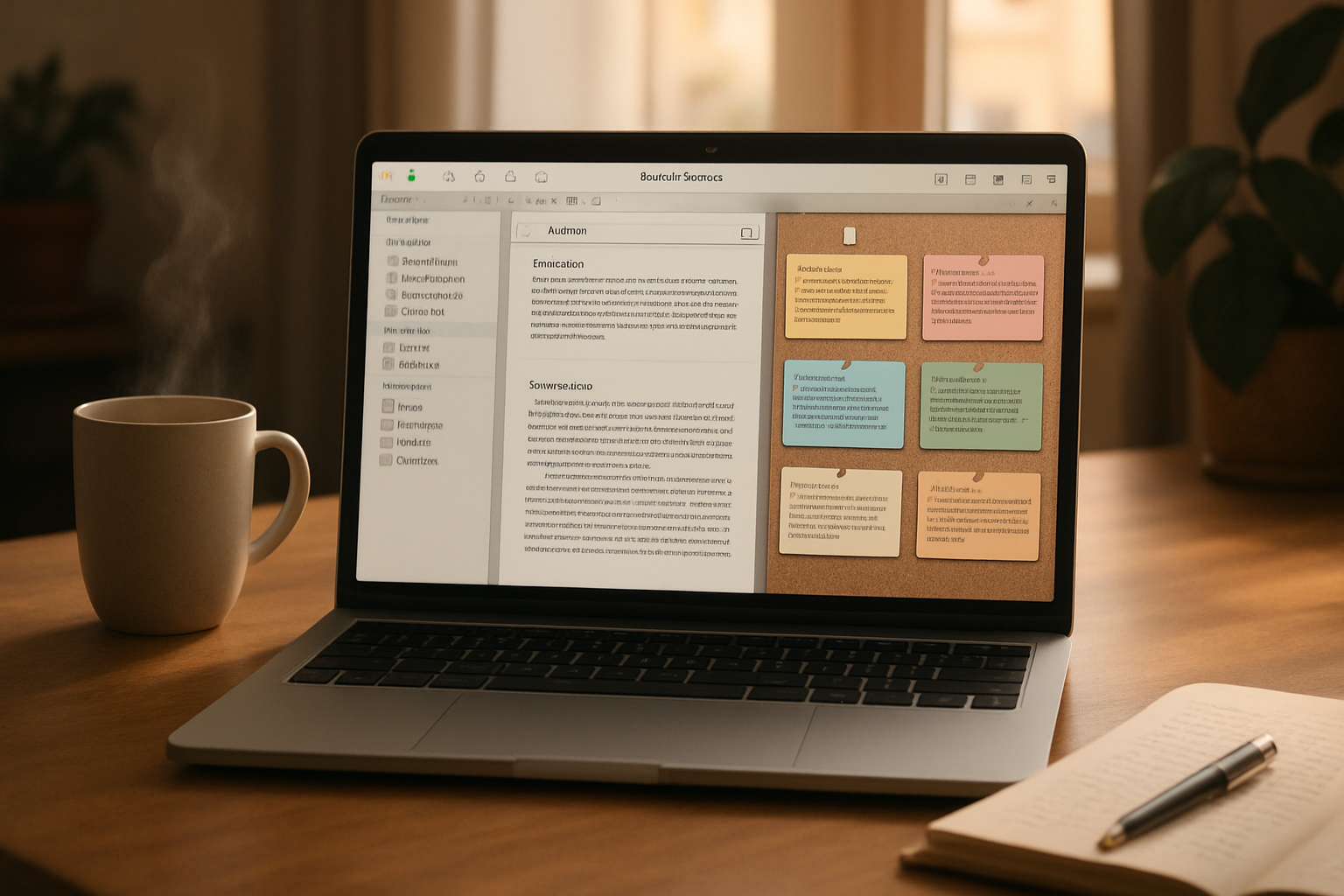· creativity · 6 min read
The Future of Writing: How Scrivener Cloud is Changing the Game for Authors
Cloud-based writing tools are reshaping how authors draft, edit, and publish. Scrivener Cloud brings Scrivener’s powerful project-centric features to the browser, streamlining collaboration, preserving structure, and letting teams work together without sacrificing the craft tools authors love.

Why the writing world moved to the cloud
For decades, authors worked with a mix of physical notebooks, single-file word processors, and desktop writing apps. Over the last 10–15 years, however, collaboration, mobility, and access from multiple devices have pushed writing into the cloud. Tools like Google Docs and Microsoft Word Online made real-time collaboration and simple, device-agnostic workflows mainstream (Google Docs, Microsoft Word Online).
But many long-form writers - novelists, researchers, and screenwriters - need more than a single linear document. They need structure (chapters, scenes, research), flexible export options, snapshots of earlier drafts, and a workspace that maps to creative processes. That’s where a hybrid approach - the power of Scrivener combined with cloud accessibility - becomes transformative.
What Scrivener Cloud brings to the table
Scrivener has long been valued for its ‘project’ paradigm: a single project file that contains the manuscript, research, notes, character sketches, and metadata. Scrivener Cloud extends that model by making projects available from a browser so collaborators and authors can access Scrivener projects without installing the desktop application.
At a high level, Scrivener Cloud offers:
- Browser-based access to Scrivener projects so you can work on or review projects from any device with a web browser.
- A way for editors, beta readers, or co-authors to participate without buying and installing a desktop license.
- Preservation of Scrivener’s project structure (Binder, Corkboard, document folders) rather than flattening everything into a single document.
(For more details on Scrivener’s features and product offerings, see the official site: Literature & Latte - Scrivener and the Scrivener Cloud information page: Scrivener Cloud - Literature & Latte).
How Scrivener Cloud changes collaborative workflows
Rather than forcing authors and editors into a generic document workflow, Scrivener Cloud respects the project-based way many writers actually work. Here’s how that changes collaboration:
Preserve structure and context
With Scrivener Cloud, chapters, scenes, research notes, and synopses remain in their original places. That context matters when an editor suggests a change - you can see where a scene sits in the larger arc, access notes about characters, or review research without switching tools.
Lower the barrier to participation
Beta readers and editors can access projects via a browser without owning Scrivener. That simplifies feedback cycles and reduces friction during critique rounds.
Safer multi-person workflows (when used correctly)
Unlike live-collaboration editors that allow multiple people to type in the same document simultaneously, Scrivener Cloud supports collaboration in ways that align with Scrivener’s model - reviewers can read, comment, and make changes that are synced back to the project. This lets a single-source project remain authoritative while enabling distributed contribution.
Integration with desk-based power features
Authors can compose on the desktop with Scrivener’s advanced tools (snapshots, compile options, label/metadata schemes) and use the cloud for access, review, and lightweight edits. That hybrid setup blends the best of deep-authoring tools with the convenience of web access.
Key Scrivener Cloud features authors will care about
Project preservation - The binder, folders, corkboard index cards, and project metadata carry through to the web view, keeping your project’s architecture intact.
Device-agnostic access - Open your project on a tablet, a Chromebook, or someone else’s laptop without extra installs.
Commenting and review workflows - Invite editors and readers to annotate and leave feedback where it’s most useful - next to the specific scene or note.
Sync compatibility - Scrivener Cloud is designed to work alongside desktop Scrivener, letting you sync changes between web access and local projects when you return to the desktop app.
Read-only and contributor roles - Control who can comment, read, or edit so a project’s integrity remains protected while still getting input from collaborators.
Export/Compile continuity - When it’s time to prepare a manuscript for submission or publication, you can still use Scrivener’s robust compile system on the desktop to produce clean outputs (e.g., Word, PDF, ePub).
Practical workflows using Scrivener Cloud
Here are three sample workflows showing how Scrivener Cloud fits into common author/editor scenarios:
Solo novelist with remote beta readers
- Draft locally in Scrivener on your desktop, using snapshots and labels.
- Upload or sync the project to Scrivener Cloud and invite beta readers in read/comment mode.
- Collect comments and incorporate the most important suggestions back into your desktop project.
Author + editor iterative process
- Share a project link with your editor for chapter-by-chapter review.
- The editor annotates scenes and suggests structural changes in place, keeping feedback anchored to context.
- You download the revised project to the desktop, integrate edits, and run a compile once the structure is finalized.
Collaborative co-authoring (staggered editing)
- Co-authors work on assigned sections, each committing changes at agreed checkpoints (e.g., daily or after each scene).
- Use project metadata and labels to track who’s responsible for what and what stage each piece is in (draft, revision, final).
Tips to get the most from Scrivener Cloud
- Establish sync rules - Decide whether edits on the web are authoritative or whether the desktop project remains the master. Consistency avoids loss of work.
- Use role-based invites - Give reviewers comment-only access when you want feedback without edits.
- Keep a versioning habit - Use Scrivener snapshots and periodic saved exports so you can roll back easily.
- Document your team workflow - For co-authoring, agree on checkpoints and a process for merging larger structural changes so edits don’t collide.
Limitations and considerations
No tool is perfect for every use case. A few factors to weigh:
Real-time simultaneous editing - If you need the Google Docs–style experience where multiple people type in the same paragraph at once, Scrivener Cloud may not replace that - it emphasizes project integrity, structure, and controlled collaboration rather than free-for-all real-time edits.
Learning curve - Scrivener’s power comes with complexity. New users will benefit from tutorials and a short onboarding period to learn the Binder, corkboard, compile presets, and other concepts.
Privacy and backup - As with any cloud service, consider privacy policies and keep local backups. Use Scrivener’s snapshot and export tools to archive important versions.
Why this matters for the future of writing
Cloud tools democratize access and simplify collaboration, but many cloud-first apps sacrifice the craft-oriented features long-form writers rely on. Scrivener Cloud represents a middle path - bringing Scrivener’s structure and author-focused tooling into the cloud era.
That balance matters because the future of writing is not just about where we type, but how tools respect the creative process. Authors need both fluid access and the ability to manage complex projects, draft non-linearly, and produce publication-ready files. When web access, reviewability, and project fidelity coexist, the result is faster feedback loops, reduced friction in collaboration, and more time for actual storytelling.
Final thoughts
Scrivener Cloud doesn’t try to be every tool at once. Instead, it offers what long-form writers and their collaborators really need: project continuity, structured context, and web-based accessibility. For authors who wind up juggling research, character notes, and multiple drafts, that combination can meaningfully change how books get written.
If you’re curious, try a small experiment: take a current project, sync it to the cloud, invite a trusted reader, and run one round of in-place feedback. The learning from that short cycle will tell you whether a Scrivener-led cloud workflow fits your creative process.
References
- Scrivener - Overview and feature guide - Literature & Latte:
- Scrivener Cloud product information - Literature & Latte: https://www.literatureandlatte.com/scrivener-cloud
- Google Docs: https://workspace.google.com/products/docs/
- Microsoft Word (online): https://www.microsoft.com/microsoft-365/word
- Notion: https://www.notion.so/



